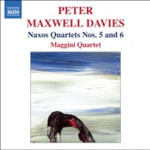
Naxos Quartets Nos. 5 & 6
 $25.00
Out of Stock
$25.00
Out of Stock6+ weeks add to cart
Peter MAXWELL DAVIES
Naxos Quartets Nos. 5 & 6
Maggini Quartet
[ Naxos / CD ]
Release Date: Wednesday 12 April 2006
This item is currently out of stock. It may take 6 or more weeks to obtain from when you place your order as this is a specialist product.
"Historically, the Maxwell Davies 'Naxos' Quartets may well be Naxos' most significant achievement. The Maggini Quartet plays this fascinating music with the utmost dedication. Those of us lucky enough to have attnded some of the Wigmore Premieres have been privileged to watch a major string quartet cycle unfold."
(MusicWeb - Recordings of the Year 2006).
"Historically, the Maxwell Davies 'Naxos' Quartets may well be Naxos' most significant achievement. The Maggini Quartet plays this fascinating music with the utmost dedication. Those of us lucky enough to have attnded some of the Wigmore Premieres have been privileged to watch a major string quartet cycle unfold."
(MusicWeb - Recordings of the Year 2006)
"Readers hesitant about "contemporary" music and ready for a challenge are warmly encouraged to try this disc"
(MusicWeb March 2007)
Naxos Quartet No. 5 has the subtitle 'Lighthouses of Orkney and Shetland', which refers not only to the dramatic nocturnal sweep of a lighthouse beam across different textures of sea and shore, but to the various lighthouse "calls" - each one can be identified by the individual rhythm of its flashes of light.
There are two movements. The work opens with a slow introduction, of which the first note, B flat, is the unambiguous tonic of the whole work. The cello, at first pizzicato, then arco, carries the main argument. A fast sonata section follows, in which I have tried to lead the ear through quite complex and constant transformations in such a way that it remains always clear how the expansions and contractions of linear contour relate, and where in our journey we are in relation to the tonic, and to its dominant and subdominant, or their displaced substitutes. I regarded this as "play" - ludus - shades of Quartet No. 4 - with the constantly changing illuminated surfaces and shapes of the wave, and the relative strengths of the lighthouses' sweeps of light across them. In Orkney and Shetland you can usually see several lighthouses at the same time when out at sea. The exposition of the sonata ends with vigorous upward scales on violins one and two, then four big crescendo tremolos, the last with a long pause. The development is short and dramatic, and extends and distorts gesture, rather than expanding the modal spectrum or changing thematic material in a new way. The recapitulation is a much shortened version of both the introduction and the exposition, with the introductory material now played presto. A brief coda takes us to C minor - the "wrong" tonality with which to end, but the "right" place in the ongoing process - the opening of the second movement resolves this, but returning to B flat. This is a slow movement using the same material entirely, and with the same form. This development is also about intensifying gesture, and here, at the end of the recapitulation builds the climax of the whole work. The coda goes right back to the opening of the first movement, and I thought of its ultimate fade-out as the sweeping beam of the North Ronaldsay light dissolving into the first light of dawn, a phenomenon I see, and enjoy, most days.
The quartet is dedicated to Thomas Daniel Schlee, composer, administrator and friend, with affection and gratitude.
Naxos Quartet No. 6 was written in December 2004 and January 2005. It is an ambitious work of six movements - a counterbalance in the cycle of ten quartets to the relatively slight fourth and fifth. I have recently been studying again Beethoven's late quartets, and, although I am well aware that I could never aspire to write work remotely approaching such a model, I trust these studies show through positively in the present work.
The first movement is an allegro whose tonality becomes ever clearer, or, rather, relationships are gradually exposed between chords which will be more fully explored and fleshed out later. The second movement, based on an Advent plainsong, is entitled Dominica Tertia Adventus, Antiphona, and is a short scherzo and trio, in pizzicato. The third movement is a second scherzo, with trio, of a more substantial nature, though still quite brief. The return of the scherzo material is varied, and prepares the listener for the fourth movement. The fourth movement is an adagio contrasting sections of warm lyricism with a more dramatic and dissonant central section. Towards the end, each instrument has a recitative, during which the other three players hold sustained chords: the last bars of the movement are the first in the Naxos Quartets to have a key-signature, of four flats, for F minor. It was Christmas Day when I wrote the fifth movement, before movements three and four, and it is based on a Christmas plainsong, and becomes a simple carol. The finale is quick, and takes up again material from the first movement, expanding and transforming this.
The quartet is dedicated to Alexander Goehr.
Tracks:
Naxos Quartet No. 5, "Lighthouses of Orkney and Shetland"
Naxos Quartet No. 6



